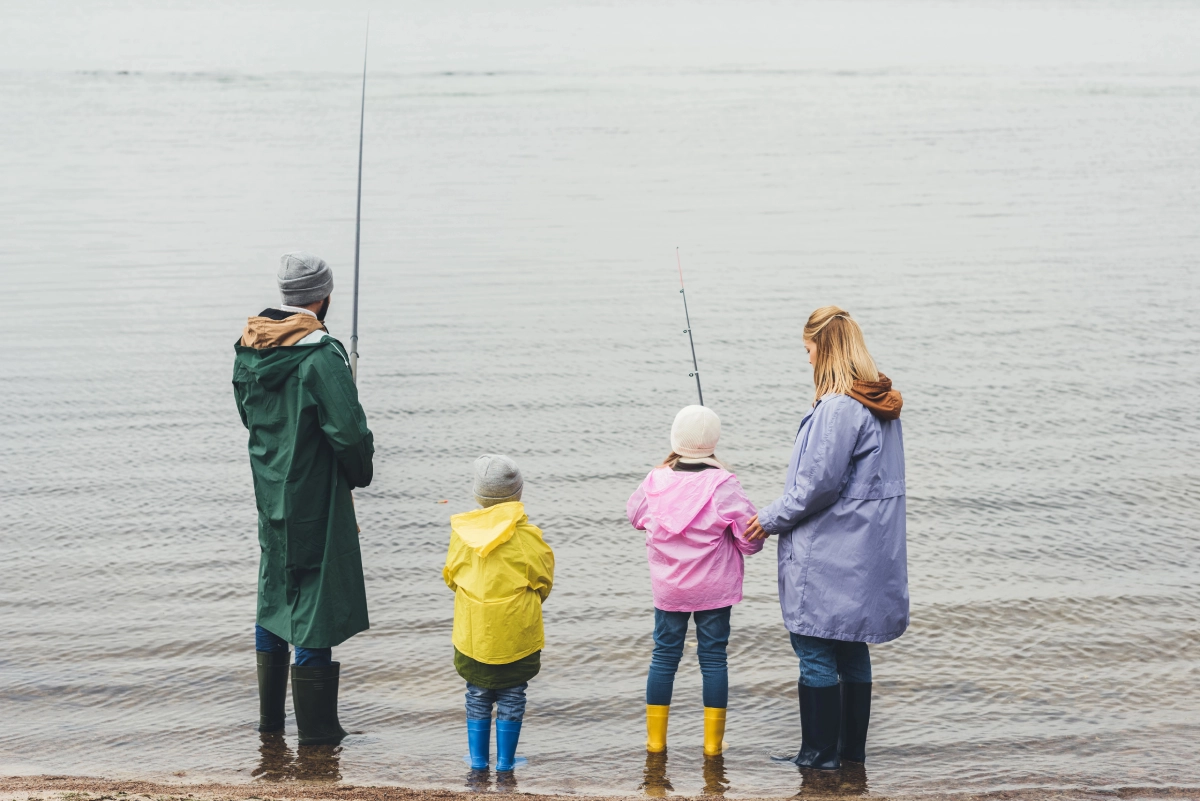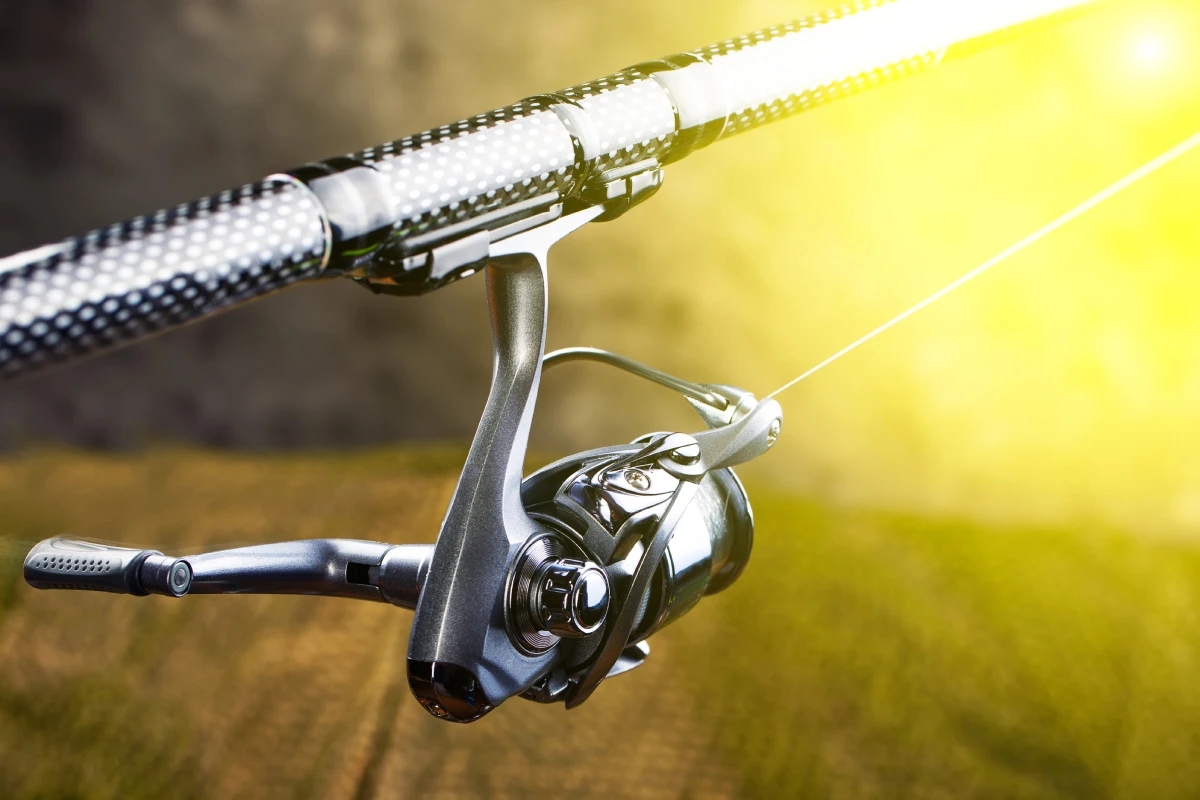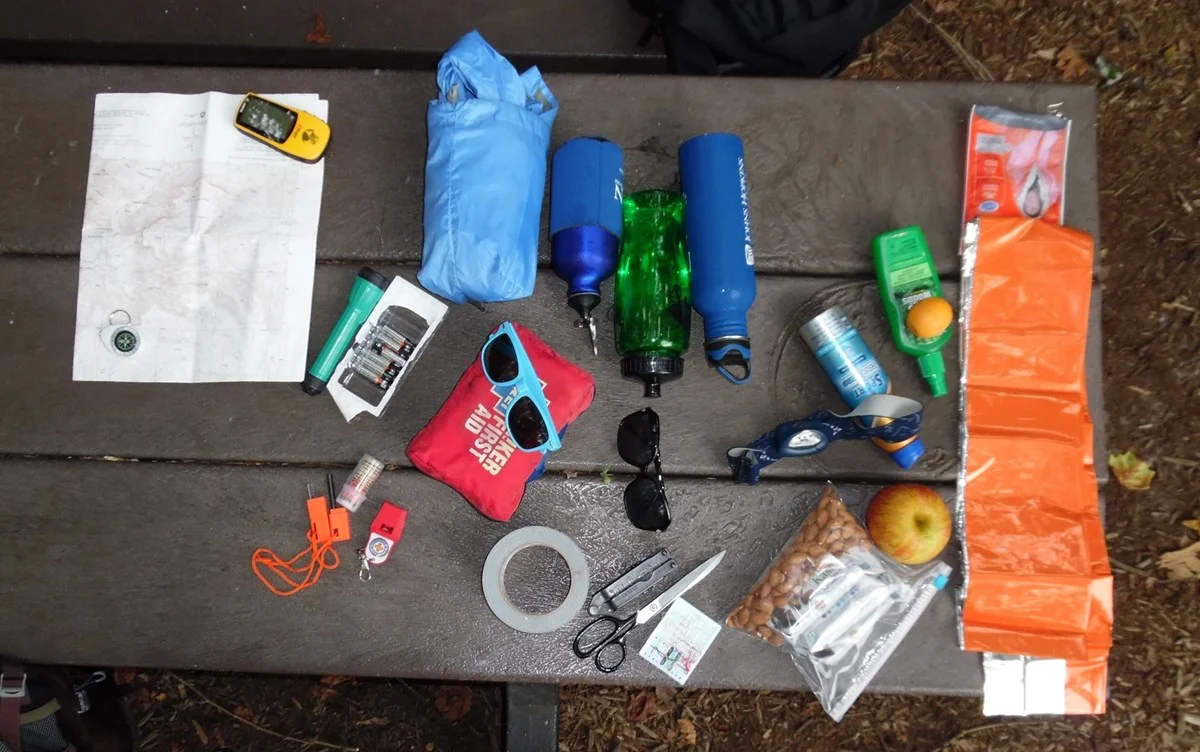Freshwater fishing and its gear isn’t as complicated as many newcomers might think. Today, I’m going to give you eleven freshwater fishing tips for beginners. Completing each of these tips can help ensure yourself a successful day casting.
To help you navigate this article, there is a clickable table of contents to move to a specific section. Otherwise read the entire article, okay let’s begin.
First Tip: Safety Is Paramount
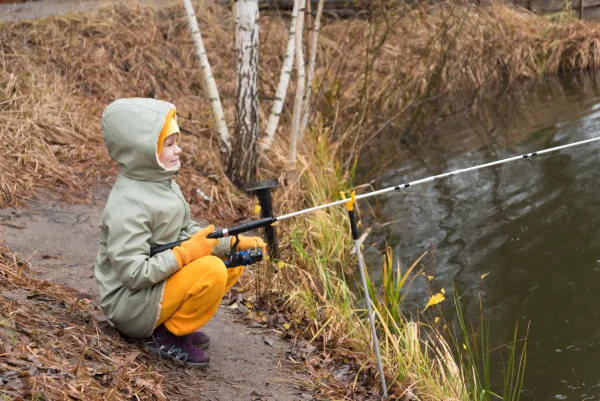
Before heading out to fish it’s important you have the proper fishing license. The last thing you want to have happen is getting caught out fishing without them, you could be in big trouble. With this in mind, follow local rules and don’t fish in unrestricted zones.
Next make sure to check the weather forecast before heading out. Don’t attempt to fish if lightning is in the forecast and if some starts while out, come in immediately.
Another safety issue is to be smart around fishing hooks. These are sharp objects, always be careful as you handle them. Likewise take a look around you to ensure the coast is clear before beginning a cast.
If you are going to fish in an open style fishing boat, everyone needs to wear a life jacket. In fact, I always make children wear a life jacket anytime they are fishing. It’s crucial to understand that safety is your number one concern around a large body of water.
For novices who are feeling confident and want to wade into the water, make sure to wear proper waders. Another added tip for this type of “fishing footwear” is to ensure to wear a “wader belt.” This is an elastic belt to prevent water from rushing into your waders. Trust me, water in your waders is uncomfortable and dangerous because it can act like an anchor in your boots.
Finally, bring plenty of water or drinks to stay hydrated and happy as you fish.
Second Tip: Use The Right Fishing Rod and Reel
The next tip for newbies to freshwater fishing is to use the right rod and reel. You will see several types of rods on the market, most anglers choose between a spinning or a bait casting rod. The easiest way to tell the difference between these two rods is the reel attachment point.
On a spinning rod, the reel will attach to the bottom of the rod. Whereas on a casting rod, the reel attaches on the top of the rod. To ease the learning curve we recommend first timers to freshwater fishing to use a spinning rod and reel. Unless you are teaching kids, for them it’s best to teach them with a “spin cast” reel. But for the purpose of this article I’m writing recommendations for adults.
Another reason I prefer this set up is because it’s much easier for casting. This is one of the most important skills to learn for fishing, regardless if you are in freshwater or saltwater. As you gain experience you can always upgrade to the bait casting rod and reel.
The reason bait casting set-ups are for experts is due to the ‘backlash’ effect. A backlash is the result of making mistakes as you cast that choke up and result in a tangled mess of line. Mistakes happen due to poor casts, blustering winds or putting the wrong amount of line on the reel.
Beginners Freshwater Spinning Rod
To distinguish a spinning rod you will see a long and thin rod blank. It has many guide rings attached to the bottom of the rod. Spinning rods will range in length between 5 to 9 feet.
As a beginner look for a rod around 6 foot 6 inches in length. This is the most versatile length for your needs.
Next you need to choose the “action” of the rod, this refers to the flexibility of the rod. This flexibility aids in making long distance casts. In general each action depends on what type of fish you target, a casting technique and the type of lures you use. Using a **medium action spinning rod** is ideal for you to learn on. A medium action rod will bend near the middle part of the fishing rod, which is more forgiving for newbies.
To add to your confusion about fishing rods is the “power” rating of the rod. The best way to understand power is to realize it’s the opposite of “action.” Power refers to the rods’ ability to resist flexing. This ability is important for rod bends under weight (like when a fish bites and fights). You use power ratings to help you target specific sizes of fish. To find the power rating of a rod, look for the lure and line weight ratings. The rating might be on the box or labelled on the side of the rod.
As a novice, use medium power to match the action, this will result in a balanced and strong rod. Look for an actual line weight rating on the rod spanning between 6-12 pounds.

Match Your Rod With A Spinning Reel
Since fishing is about having fun, you shouldn’t be sweating over a tangled line. Do yourself a favor and match the spinning rod mentioned before with a spinning reel. A spinning reel is an open faced reel that shows the fishing line. With this type of reel, as you turn the handle the spool of the reel will rotate as well.
The Right Spinning Reel Size
After you know the type of reel, what size should a beginner use? It’s in your best interest to get one that is lightweight and well rounded for many types of species.
To find reel size you look at the specifications on its box or a label on the reel. Fishing reel ratings are simple: the smaller the rating the smaller the reel is. Don’t take this as gospel though, because some manufacturers label their reels with their own rating. A “35” from one brand might be the same as a “3500” from another. That’s confusing, because both are the same size reel. Below are typical lightweight spinning reel sizes between different brands.
Small spinning reels – 10/1000, 25/2500, 30/3000, 35/350/3500
Moving on, the next rating on the reel or box is the gear ratio. These are numbers which denote how many rotations of the spool per one complete turn of the reel’s handle.
A 4:1 is a slow reel, a 5:1 is a medium speed reel and a 6:1 is a fast speed reel.
Next, you need to pick a line weight for the reel, printed on the reel. Such as 6/230, which states the following.
260 = The amount of fishing line (length in yards or meters) the reel can spool.
6 = pound weight strength of the of line.
For what size spinning reel to use, the start with the following size:
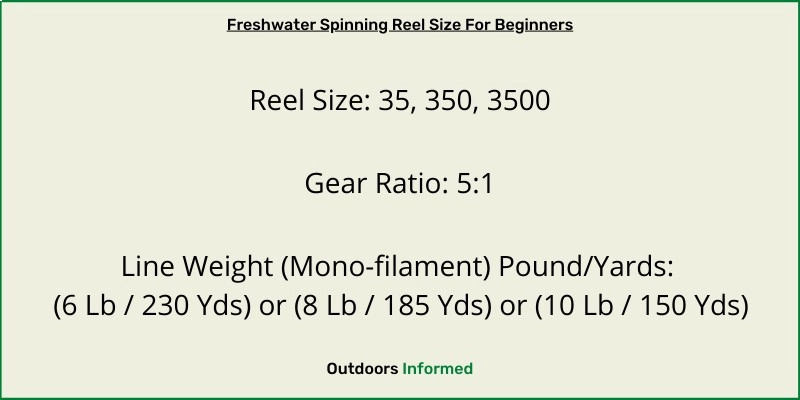
By using this reel, you will have ample room to be a beginner and can use this same reel as you grow in experience.
Third Tip: Pick A Type Of Freshwater Fishing
Next you will want to identify a which type of fishing is best for the techniques you want to learn. Picking simple techniques and a type will add to the fun of your first attempts at fishing. Which type you pick depends on:
- Location.
- Size of the body of water.
- Species of fish you want to target.
- Equipment you have access to.
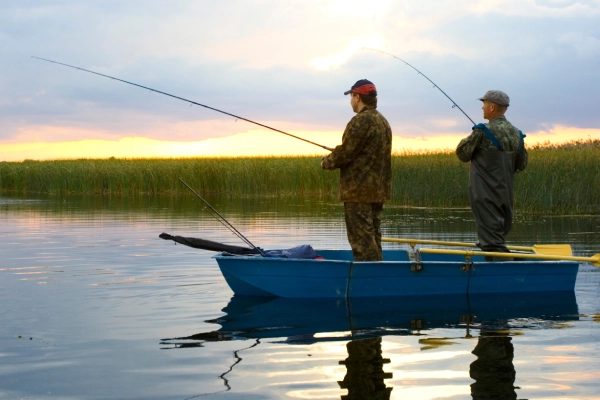
Freshwater Fishing On A Boat
Angler use boats for one main reason, to access the middle of a lake or rive to drop their bait or lure. Using a boat to freshwater fish can help to find more target zones and enables you to cover more surface area. Doing this increases your odds of catching bigger species of fish.
Beginners can use small rowboats, canoes, or kayaks to target strike zones on small ponds or on rivers. These are great to navigate bodies of water that are shallow. If in bigger water sources like deep lakes or rivers like the Mississippi, you’ll need a sport fishing boat. Boat anglers use a rod and reel, for methods that range from trolling for Northern pike to bass fishing.
Using A Boat For Trolling
This is a specific fishing technique that uses the motion of the boat to target fish. Don’t confuse this with trawling, which uses a net pulled behind the boat. For trolling anglers drop many fishing lines with baits or lures off the rear of a boat. Using outriggers to spread the lines and downriggers to keep the lures or bait at a desired depth. It’s a great freshwater technique for catching fish species like salmon and mackerel. But out of the wheel house of absolute beginners to fishing.
Static Fishing From A Dock, Jetty Or Shore
Static fishing is the easiest method and oldest type of freshwater angling. This type of fishing uses a reel and rod with a weighted line, a bobber and a baited hook or lure. It’s the ideal type of angling to benefit novices because it allows them to learn the basics of fishing. There isn’t any need to use a boat or expensive technical gear beyond rod/reel and terminal tackle.
Fourth Tip: Learn The Big Lob Cast Technique
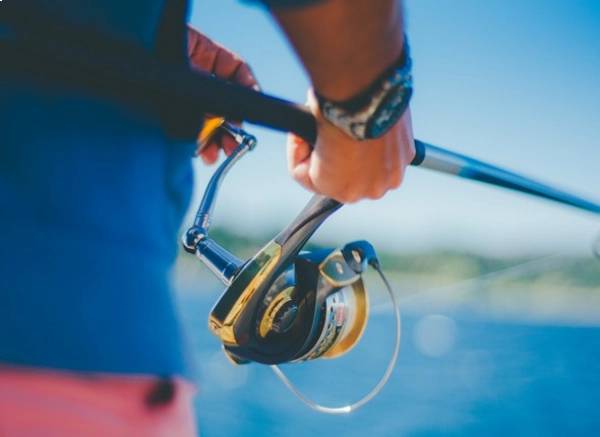
This is the most common cast beginner anglers should learn. It’s also a common cast method for semi experienced saltwater anglers. The object of this casting technique is to “lob” the line out as far as possible into the water. Below are six steps to complete the big lob casting technique.
First Step
Open the bail on the reel and pull out some fishing line. Pull out enough line so that the bait or lure is hanging 12 inches below the end of the rod. After close the bail on the reel.
Second Step
Next, grasp the rod handle at waist level, with the reel below the rod. The ideal fitment is to have the stem of the reel split between your ring and middle finger. Although for some anglers it feels better between other fingers. Do what’s comfortable for you.
Third Step
Hook the fishing line with your index finger and open the bail while keeping a finger on the line. By opening the bail you “unlock” the reel to allow for casting.
Fourth Step
Start the actual cast by extending your arms with the rod tip upward and behind over your dominant shoulder. Let the rod tip flex (bend backward) and begin to lob the rod forward swiftly at your target.
Fifth Step
As the rod gets half way toward the target let go of your index finger on the line. The weight of the lure and the forward motion with pull the line out of the reel high into the air. If done right it your bait/lure will land at your target area.
Sixth Step
Finally, to retrieve the lure or bait, you will close the bail with your free hand. Turn the reel handle to pull in the line to you.
As you practice the big lob technique ensure you pay close attention to the movement of the fishing line. It’s important to learn the difference between getting snagged or a biting fish that you hook and reel it in.
Two Spinning Reel Casting Problems & Solutions:
Some first timers become frustrated during the period they are learning to cast. To help lower annoyances below are two common problems and their solutions.
First problem, the lure goes straight up in the air. This means you released your index finger early. A solution, give yourself an extra half second to release the line.
Second problem, the lure crashes down at your feet. This happens when you release your index finger late. A basic solution for this is to release your finger half a second early.
Like any technique in fishing this casting method is all about practice makes perfect.
Fifth Tip: Use Basic Freshwater Tackle
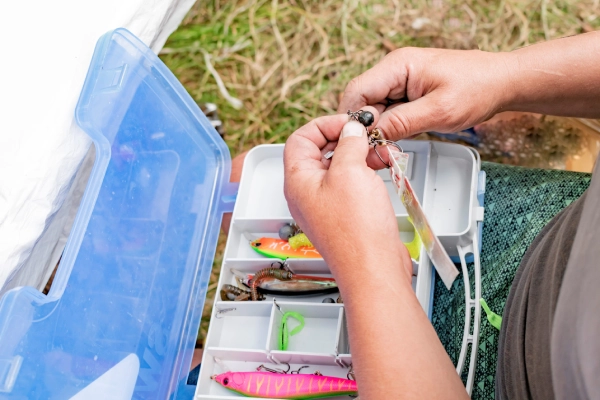
As a beginner there is no reason to have to buy expensive tackle box items. Look for items that are budget friendly, ones that you aren’t afraid to lose. By using cheaper tackle you can be braver while fishing. To keep my tackle protected I keep mine tackle inside a plastic tackle box. Plastic won’t rust like metal tackle boxes.
Let’s talk about what to put in your first freshwater tackle box. Below is a list of the basic tackle you should have as a beginner to freshwater fishing.
1. FISHING LINE
Fishing line is cable-like material which is the physical link between you and the fish. The type of line is very important to anglers because it can make or break a day out fishing. Likewise choosing between which type of fishing line can be confusing, since there are so many types. Such as monofilament, fluorocarbon, braided and others.
To lessen confusion, beginners to freshwater fishing should use the monofilament line type. This type is cheaper and has a versatile tensile strength for freshwater fishing.
After you know the type of line and next you need to choose a pound weight rating. This rating refers to the strength of the line. Another way to think about it is, this is the amount of weight required to snap the line.
For a novice we recommend a monofilament line with a pound weight of 8 or 10 pounds. This set up is ideal for freshwater fishing.
2. BOBBERS
Some anglers call these floats, you use a bobber to suspend your bait or lure at a particular depth underwater. Another use of it is to help you know when a fish strikes. The smaller a bobber the better. As long as it is big enough to have the bait/lure moving underwater and you can notice the slightest nibble.
While a round bobber is easier to cast, a pencil-style bobber is easier to see a fish strike. Both are good options for a beginner, so choose which feature is more important to you.
3. SINKERS
Sinkers are exactly what the word sounds like. It’s a weight that attaches to the line, to help make far casts and will sink the bait or lure underwater. Classic sinkers have lead inside them and are poisonous, while new materials are tin or tungsten.
You will find several types of sinkers, which will differ based on size and weight. From ¼ ounce split shot sinkers about the size of a BB up to 5-pound cannonball sinkers.
The key to using sinkers is getting the weight right for the area you are fishing. Too little weight means your bait or lure won’t sink to the depth you want. Whereas a super heavy weight will sink a bait or lure to the bottom. This can startle nearby fish, making them swim as far from you as possible!
As a beginner keep a variety of small to medium sized sinkers in your tackle box. This way you can make quick switches.
4. HOOKS
This is a curved piece of wire with a sharp “barb” at the pointed end of the curve. It is the barb that hooks into the fish when it bites the bait or the lure. At the top of the hook is a round eye to attach the fishing line. You will find hooks that come in many shapes and sizes, each designed for different uses.
For beginners, it is best to use a small single hook. Try one that is either a size 6 or 7, these are a great choice.
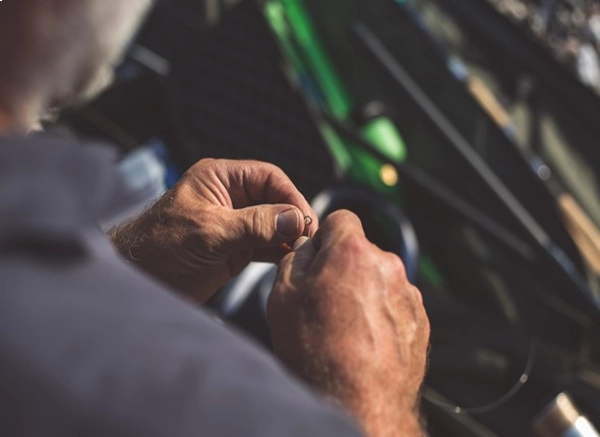
5. BAITS
Baits are either live food or an artificial substance. You use the bait to attract the fish and tempt them to bite. Live baits include worms, grasshoppers, minnows or locusts. Whereas artificial baits are unnatural substances (man-made) with scents to attract fish to bite. Examples of these include “Power Bait” or imitation salmon eggs.
For a beginner to freshwater fishing, start with worms or minnows. These are small live baits that are easy to hook and attract a variety of fish. Otherwise if you aren’t comfortable with live bait, try a green or rainbow colored power bait. These two colors are perfect for novice anglers.
6. LURES
A lure is a man-made fishing bait designed to attract a fish’s attention. It uses movement, color, vibration or reflection to attract the fish. To give a fisherman a better chance many lures have one or more hooks per lure.
Keep in mind that expensive lures suck to lose, which translates into timid fishing as a newbie. It’s better to start with inexpensive minnow plug or spinner. A minnow plug is a carved lure that resembles a minnow, it’s simple and effective.
Conversely, a spinner lure is a metal shaft with shiny spinning blade. One thing to remember about a shiny spinners, if you fish during peak sun they give off a lot of reflection. As a result shiny lures can blind and confuse fish which can scare them off. Try to find a matted silver lure if you fish in sunny locales.
7. SNAPS
Snaps are small freshwater tackle devices that function like a safety pin. To use one, you tie it to the line to provide you quick attachment or release of hooks, rigs and lures.
Sixth Tip: A Simple Fishing Rig With A Secure Knot Is Best
With everything mentioned, you will have a full tackle box. The next thing to conquer is to you learn how to create a simple fishing rig. Plus learn to tie a strong fishing knot. A fishing rig is the way you tie together the tackle to your fishing line to attract fish.
For freshwater fishing, novice anglers should create the basic bobber rig. As you become more experienced you can use different types of rigs for specific types of fish. The image below shows a basic bobber rig.
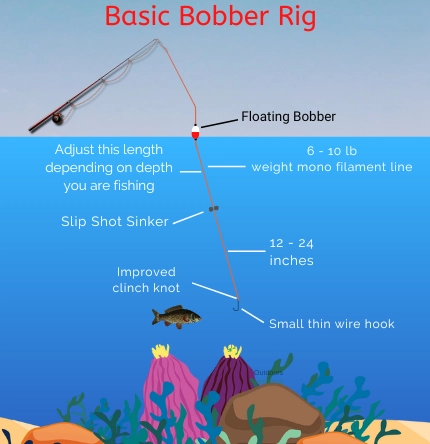
To recreate the picture above, follow these steps:
- Attach your single hook to one end of the fishing line with an improved clinch knot.
- Affix a split shot weight to the line 12 to 24 inches above the hook.
- Next attach a weighted round foam bobber or pencil-style float to the main line. Adjust the bobber based on the depth of water you are fishing. The depth range can be distances from twelve inches to a few feet.
Use A Simple Strong Knot
Using a “snap” is convenient for attaching and releasing tackle on fishing line. But it’s best to use a knot to attach a snap on the line. To do so, the most simple and strong knot you should learn as a beginner is the improved clinch knot.
To tie this knot, complete the following steps:
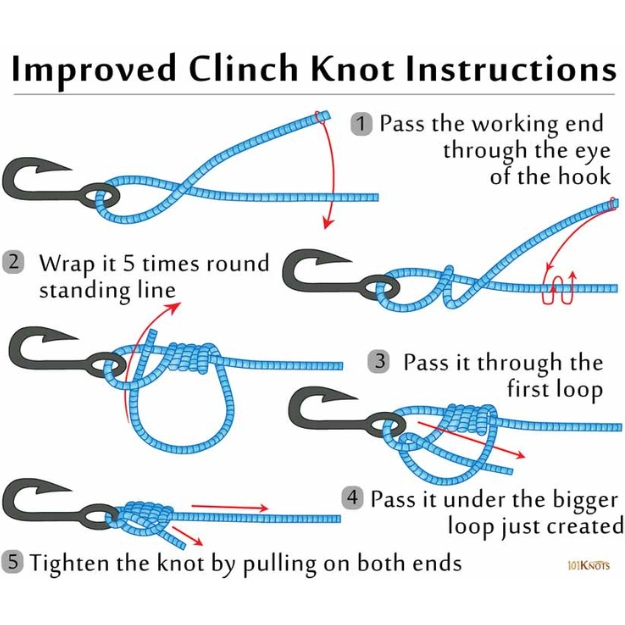
- First thread your line through the hook’s eye
- Second wrap the loose end of the line around the taut end five times.
- Third thread the loose line through the loop that’s closest to the eye of the hook.
- Forth thread it under the bigger loop you just made.
- Fifth, pull on both of the ends of the line until it’s taut. If necessary you can trim any excess line.
Seventh Tip: Layered Clothing = Dressing For Success
The goal when you are fishing is to be comfortable right? To do this you need to wear the right clothing. The following items are some basic clothing options to keep to comfortable and safe.
Lightweight Shirts
Choose shirts that are lightweight, made of breathable fabric and light in color. You may want an actual “fishing shirt,” popular versions of this shirt are short sleeved button downs. A fishing specific shirt will have a mesh lining inside and open-able flaps to increase cooling.
Another cheap and easy option is a long or short sleeve white cotton shirt. White cotton has good breath ability and light in color. Layer a short sleeve shirt over a long one for added versatility.
Next, layer on top of your chosen shirts with a flannel button up for cold weather. Or buy a quick-drying nylon button up shirt to layer in moderate weather.
One last feature to look for when shirt shopping is to look for brands with SPF factor. These kinds of shirts are quick-drying and can protect you from sun damage.
Nylon Cargo Pants and Shorts
Look for lightweight pants and shorts like you would for your shirts. Doing so will help you feel more comfortable depending on the weather. For hot days a pair nylon cargo shorts are perfect. Otherwise for cool to cold weather a lightweight nylon cargo pants is your best choice.
I recommend cargo pants because of their awesome utility. A good pair will have several pockets for you to store things like extra tackle as well as small pliers.
Many people will say you can wear jeans, but who like standing around in soaking wet jeans? I don’t, they become heavy and uncomfortable. Do yourself a favor and keep the jeans at home.
For cargo shorts try to find ones with at least a 50 SPF rating. Likewise find ones in a nylon material, light in color since it will breathe and quick dry when needed.
Waterproof Footwear
What do I wear on my feet? For me, I wear wading boots. Wading boots are the ideal footwear because they are waterproof to a certain depth. That makes for a comfortable and safe fishing experience.
The main features to look for a rubber material that’s lightweight with a soft foot-bed. Other quality features include UV resistance, slip proof treads and quick-drying. If possible find a pair with elastic laces that can provide adequate tightness. These are great since some waders can loosen and let in water which is uncomfortable and unsafe. For safety, you should add wader belts. These further reduce water filling into the wader boots.
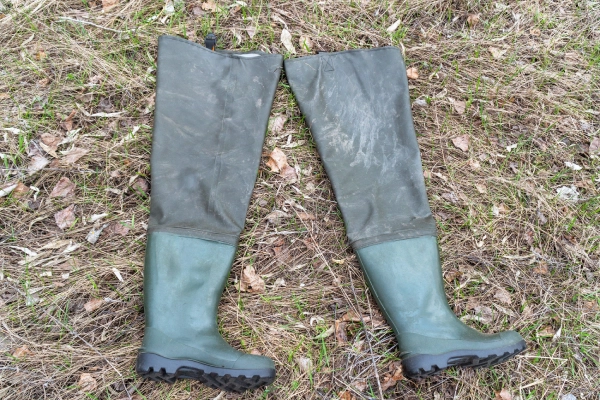
Otherwise if you are fishing in hot climates you could use a sandal. But ensure you buy one with ankle straps that is lightweight and flexible.
Head Protection
What? Yes that is right, while you may think something like a hat is unnecessary, you’re wrong. A hat is useful for protecting your head in both cold and warm weather. Fishing in the cold, it keeps your head and ears warm. For hot weather, remember that water will reflect the suns rays. A good hat will shade your face and protect your head from sun burns.
Look for a hat or another kind of head covering with a full wide brim. A complete brim will protect you from overheating and brutal sun exposure. Make sure that whatever type you buy has a breathable material as well.
Sun Glasses
Ensure you keep your eyes protected with a good quality pair of polarized sunglasses. This type of sun glasses will block the UV rays from the sun as well as the sun’s glare on the water. Plus having clear sight aids seeing well when trying to locate fish.
Gloves
Yes, many anglers don’t wear gloves, but as a novice, a pair of gloves can aid in comfort and protect you too.
As a beginner you can wear gloves in either extreme cold or on very sunny days. In the cold, gloves are obvious for keeping your hands warm. But for a sunny day? You wear them for the same reason as a hat, to protect from sun burns. In summer, I’ll wear lightweight gloves with high “UPF” protection.
Sunscreen
Last but not least, a general freshwater fishing tip for everyone. Everyone spending a lot of time outdoors needs to protect their skin. Don’t want to wear gloves or a hat? The least you can do to protect yourself is to slather on some sunscreen. Make sure to choose one that is sweat-proof and one that is not greasy. A greasy sunscreen will have adverse effects on your ability to grip the fishing rod handle.
The ideal choice would be one with a hypoallergenic, oil-free and waterproof. Ensure that you keep applying throughout the day, especially if you fish in summer.
Eighth Tip: Location Matters
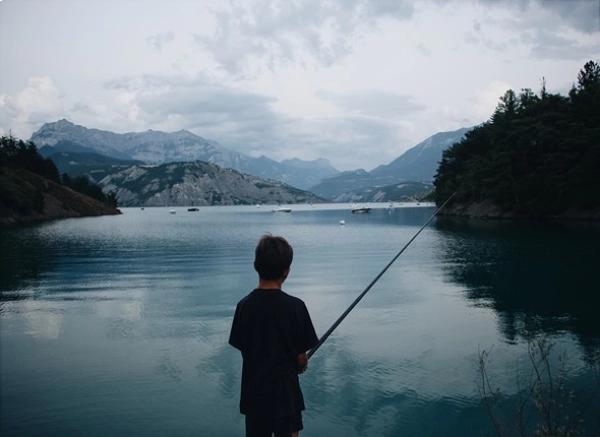
Most experienced fishermen know that not all fishing trips are a success. There are times the fish don’t bite, it happens to the best of us. Lots of new anglers think it is as simple as having the right gear and a body of water. They take a three-hour trip to the nearest lake and make tons of casts to no avail. It’s a complete failure and disappointment sets in, but it doesn’t have to be this way.
Instead of “winging it” you should do a bit of research to help your chances of hooking the fish you are targeting. First check any local fishing reports on the day for updates on areas fish seem to be biting. It is also a good idea to research the region you are fishing for what species are there and what they eat.
To help you get a head start, below are some fishing tips for each of the general types of freshwater areas.
Lake Fishing Tips
Fish At Inlets and Outlets. Most species of fish like specific temperatures to hang around in. These are great strike zones because fish congregate and look for food in these areas. Try to fish at a spot that water enters or drains from a lake. These areas tend to be much cooler and comfortable to the fish. In fact, smaller bait fish (like a minnow) will hang around these areas, along with the big fish who eat them.
Find Sunken or Floating Structures. If you don’t have any luck at inlets and outlets, another are to look for is “structures.” Fish like to hide around structures that make them feel safe. An example of a structure is a sunken trees or dead logs, these are great places to target fish. Think of these structures like what coral is in saltwater.
Windy Days Are A Plus. Days that have strong breezes will push smaller bait fish closer to shore. Resulting in hungry bigger fish coming closer to shore to feed. The best way to locate how close to shore this potential feeding frenzy might happen is to look for “drift lines.”
Spot Moss & Weeds. Bigger species like to hang out in a thick weed beds to hunt for food. A great plan of attack is to try to coax these fish with your tasty hook. Look for weed beds or mossy areas which lead to deeper water, these are the best areas.
River Fishing Tips
Cast Like A Predator. If you are river fishing, imagine being a fish seeking safety from the current and predators. Look for structures along the river bank, such as dead trees, tree stumps or branches. These areas offer shade as well as protection from birds and other predators. Plan to target and strike the fish in areas a bit outside these refuges to surprise incoming fish. Remember that these structures are also places bigger fish hang out in to ambush prey. It’s a two fold method that can be super successful.
Find Calm Areas. In rivers with a strong current, fish seek safety in calm backwater areas. Look for water that appears to be near motionless. A great casting method in these spots is to cast upstream. Then allow your lure or bait to drift down toward calm areas.
Look For Sandy Islands Or Piles Of Rocks. At the downstream side of a sandy island or rock piles, you can find calm areas of water. This is another place to search for calm areas. In this downstream calm water fish face upstream to rest. These pockets of water provide an excellent spot to target and reel in fish.
Focus On Merging Currents. Another place to attempt is areas of noticeable current shifts. These changing currents will have an area that the water slows down to a speed which fish can forage for food. Drop your bait or lure to drag through this area to entice a hungry fish.
Pond Fishing Tips
Get Permission. It’s important to remember that many fishing ponds are on private property. Don’t risk a visit from the police, get permission from a property owner before angling in these ponds.
Sight Underwater Structures. Ponds will likely only have a dock or submerged dead logs. Pay attention for any structures, they are fantastic areas to target fish. Due to them being cool shaded spot which fish use to look for food.
Scout For Vegetation. If you are fishing in a pond without structures, then look for plants in the water. Plant growth attracts bait fish, which in turn attracts the bigger fish you are targeting.
Fish At Prime Feeding Time. Pond fish are super lazy, and they hate the heat of mid day. As a result, the best times to attempt pond fishing is at feeding time. Try for early mornings or in the evening.
Use Live Baits. If you are fishing in a pond with beginners or kids, it’s best to use live baits. Worms, minnows, crickets, and wax-worms will attract a variety of fish in ponds. Hook these live baits with a hook 6 to 4 inches in size depending on the fish species you are targeting.
Ninth Tip: Weather Patterns & Water Temperature Are Crucial
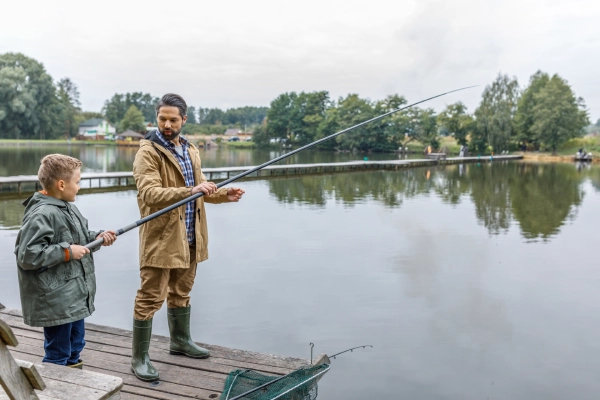
Freshwater fish, like all other species, react to the environment they live in. This means, weather is a key factor to research before leave to go attempt any type of fishing. In fact, the moon and the sun play direct roles about what time is best to fish. Some expert anglers plan to fish on days near key moon phases, since these can be prime times to fish.
Another factor fish respond to is the way weather changes affect water temperature and pressure. For example, as a cold front nears, pressure begins to fall, since fish are cold blooded, they are more active. Although if the weather turns extremely cold, fish get become lazy and uninterested. What can be confusing with the fact fish are cold blooded is rising temperatures. While they like cool water, if the temperature rises a lot they can hate it. The hotter a day becomes, the higher the pressure becomes. In this instance both the water temperature and pressure makes for an uncomfortable day for the fish.
One tried and true weather pattern to look out for is a cool day with light rain. Many anglers see an increase in bites during these days. Although getting soaked on your first time fishing may be a deterrent. If this sounds like you then try either an early summer morning or cloudy fall late afternoon.
In the summer, the early mornings shouldn’t be hot, which means more fish are out feeding. While in the fall, fish are more likely to bite in the late afternoon. The time of day is essential, so pay a lot of attention to your local fishing reports throughout the season.
Consider That Water Depth Affects Temperature
Another important consideration for water temperature is depth. Most species of freshwater fish have an optimal water temperature that attracts them. As well as a greatest and least threshold for any area they’ll be comfortable swimming in. The depth of the water is the big factor that expert anglers consider. This is because the deeper the water is, the cooler the water temperature is as well.
For learning to fish in a freshwater you’ll want to get a topographical map of the body of water. This will let you know what and where the different depths are. Along with depths some might show you locations of sunken man-made fish cribs, bonus!
After you research the weather and temperature you need to choose a specific species in advance. Let’s move on to discuss some examples to help you find success.
Tenth Tip: Target A Single Type Of Freshwater Fish
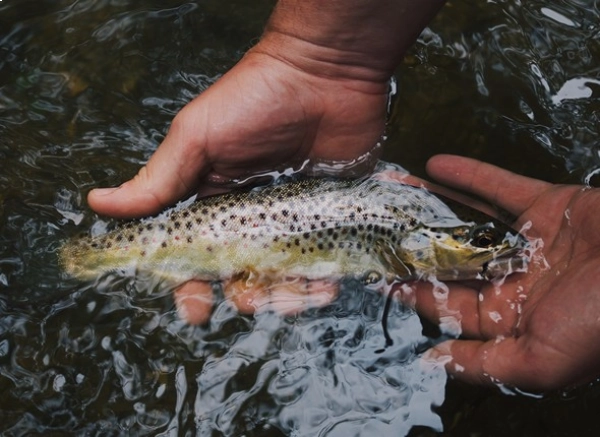
As mentioned before, if you choose one type of fish to begin your fishing journey, you should be more successful. Since single species like particular foods you can pin point which lure or bait to use. Picking a species helps you plan where to fish and what season will give you the most bites. To further narrow down a choice, below are some basic explanations of typical freshwater fish you can try to target.
BLACK CRAPPIE – Lakes & Ponds
The black crappie, also called speckled perch or “specks” is a warm water species, usually found in shallow water. Typical strike zones for this fish are in medium shallow lakes and ponds. The crappie is one of the most common fish caught by beginner anglers. It’s a easy fish to catch due to adults weighing about 3 pounds. You can fish for them in the Midwest, Northeast, West, and South regions of the U.S. as well as parts of Canada and Mexico. As you search for fishing spots, look for weed beds, logs, stumps, or near rock piles. These fish love insects and small fish, so worms or minnow plugs are great for targeting black crappie.
LARGEMOUTH BASS – Lakes & Ponds
This is the most popular freshwater game fish in the United State. The largemouth bass has a long mouth which extends to at least and beyond the rear edge of the eyes. An average adult largemouth bass weighs in at around 12 pounds. This species inhabits lakes and ponds in in the center and eastern side of the U.S.. Like the black crappie they enjoy insects and small bait fish. Locations to target are near structures and deep vegetation. Keep in mind that this species is smart and are aggressive feeders. If you don’t get a bite within five to 10 minutes, it’s time to try another spot.
WALLEYE – Lakes & Ponds
Another popular fish species found throughout the U.S. is the walleye or yellow pike. This species has large, glass like, opaque eyes which give the fish its name. In fact, in shallow water at night, its eyes glow when light shines near them. This glow will identify the fish even before you actually see fish movement. For weight, an adult walleye can be over 24 pounds! Most walleye will hang out under the safety of structures. Use a basic bobber rig, with either a minnow plug or a spoon lure for best results. My favorite time to try to hook walleye is in the dark of night.
CHANNEL CATFISH – Lakes & Rivers
This is a tasty species, found in the central and southern states of the U.S. as well as Canada and northern Mexico. It is the official fish of Kansas, Missouri, Iowa, Nebraska, and Tennessee. Catfish will have a deep forked tail fin and several spots on their body. As well, they have ” cat whisker” like faces. They range in size from about five pounds up to over forty pounds. This fish will hang out on sandy bottoms of large lakes or rivers. You can also try structures and shallow calm areas with this fish. Your best bet for catching a channel catfish is to fish at dusk. Try a “power bait” or live minnows, this species love scented baits.
RAINBOW TROUT – Lakes, Ponds & Rivers
Rainbow trout are the most common freshwater sport fish. You will know you are looking at one by their vivid and colorful markings. Find this species in the Midwest, Northeast, South, and West of the U.S. as well as southern Canada. These can weight up to 27 pounds as adult fish. This powerful fish can jump clear out of the water when hooked! Look for them by overhanging trees, near merging currents, in the mid-top area of water. The best time of year to catch rainbow trout is Spring or Fall, in morning or evening. Use insects, or artificial baits (fake salmon eggs) for best results.
Eleventh Tip : Please Follow Local Fishing Rules
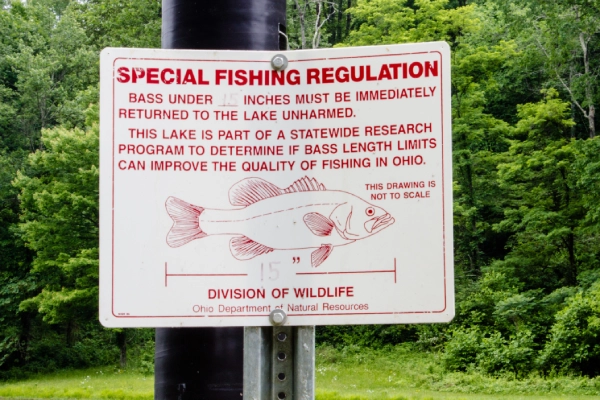
The last thing anyone wants to do is over fish and hurt our fish stocks. As a novice there are three main “limits” you should know and follow. These are a slot-length limit, creel limit, and possession limit. Below is a brief definition of each.
- A slot-length limit stops anglers from keeping fish within a certain size range. You will need to check you regions rules to get you exact slot- length limit. For example, a slot length limit for bass could be is 13-18 inches. This means if you catch a bass between 13 and 18 inches long, you have to return it to the water.
- Whereas a creel limit indicates the largest legal daily quantity of fish you can catch. Don’t confuse this with a possession limit.
- A possession limit is 2 times the creel limit per person. This allows for transportation of 2 days worth of legal fishing when on a fishing trips.
Remember to be mindful when fishing, and fight man made pollution. Pack out all your trash, especially all used fishing line.
Finishing Up: Freshwater Fishing Tips For Beginners
Here’s an extra tip, one that’s universal, be patient. Patience is the key to becoming a successful angler. Bring a book or radio with ear phones if you plan to out for a long time. If you do feel bored, remind yourself that the best things come to those who wait.
